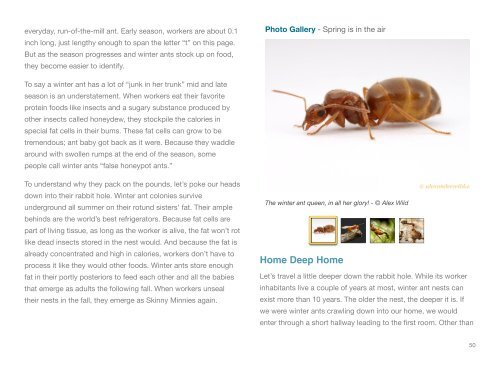th15IH
th15IH
th15IH
Create successful ePaper yourself
Turn your PDF publications into a flip-book with our unique Google optimized e-Paper software.
everyday, run-of-the-mill ant. Early season, workers are about 0.1<br />
inch long, just lengthy enough to span the letter “t” on this page.<br />
But as the season progresses and winter ants stock up on food,<br />
they become easier to identify.<br />
Photo Gallery - Spring is in the air<br />
To say a winter ant has a lot of “junk in her trunk” mid and late<br />
season is an understatement. When workers eat their favorite<br />
protein foods like insects and a sugary substance produced by<br />
other insects called honeydew, they stockpile the calories in<br />
special fat cells in their bums. These fat cells can grow to be<br />
tremendous; ant baby got back as it were. Because they waddle<br />
around with swollen rumps at the end of the season, some<br />
people call winter ants “false honeypot ants.”<br />
To understand why they pack on the pounds, let’s poke our heads<br />
down into their rabbit hole. Winter ant colonies survive<br />
underground all summer on their rotund sisters’ fat. Their ample<br />
behinds are the world’s best refrigerators. Because fat cells are<br />
part of living tissue, as long as the worker is alive, the fat won’t rot<br />
like dead insects stored in the nest would. And because the fat is<br />
already concentrated and high in calories, workers don’t have to<br />
process it like they would other foods. Winter ants store enough<br />
fat in their portly posteriors to feed each other and all the babies<br />
that emerge as adults the following fall. When workers unseal<br />
their nests in the fall, they emerge as Skinny Minnies again.<br />
The winter ant queen, in all her glory! - © Alex Wild<br />
Home Deep Home<br />
Let’s travel a little deeper down the rabbit hole. While its worker<br />
inhabitants live a couple of years at most, winter ant nests can<br />
exist more than 10 years. The older the nest, the deeper it is. If<br />
we were winter ants crawling down into our home, we would<br />
enter through a short hallway leading to the first room. Other than<br />
50


